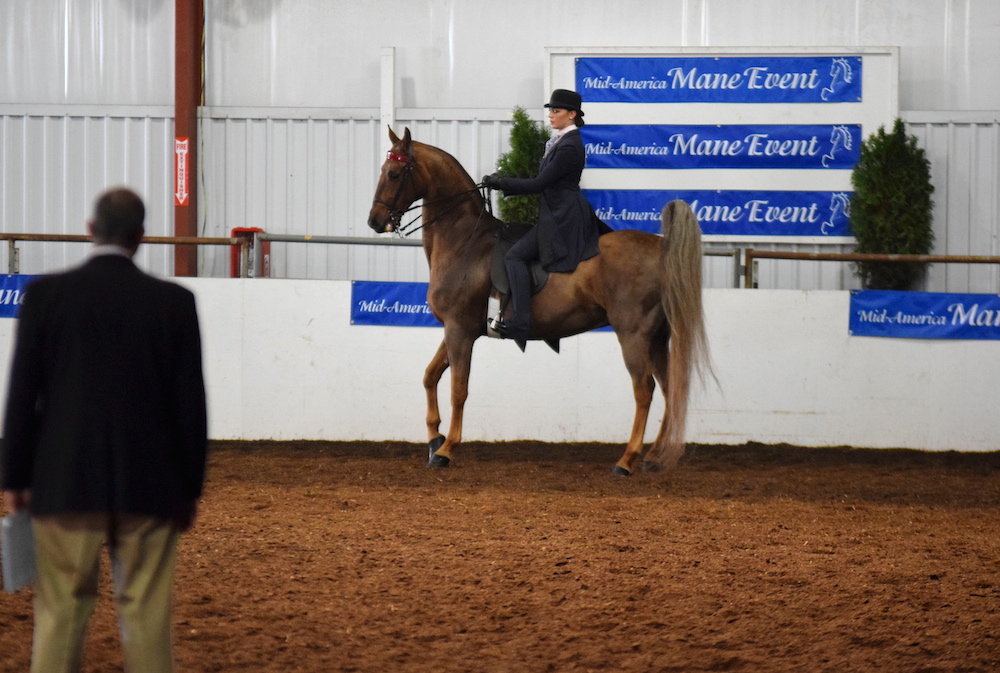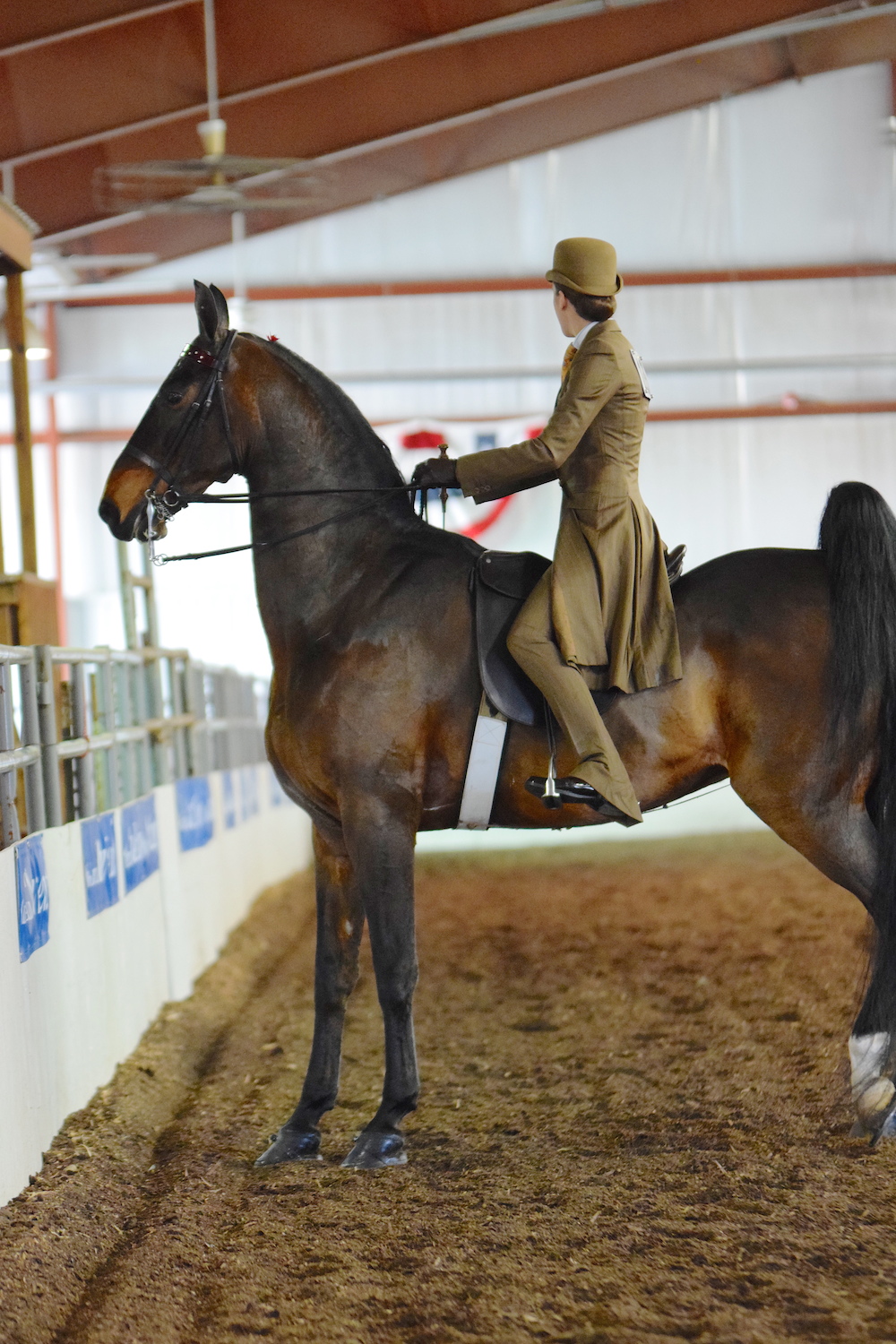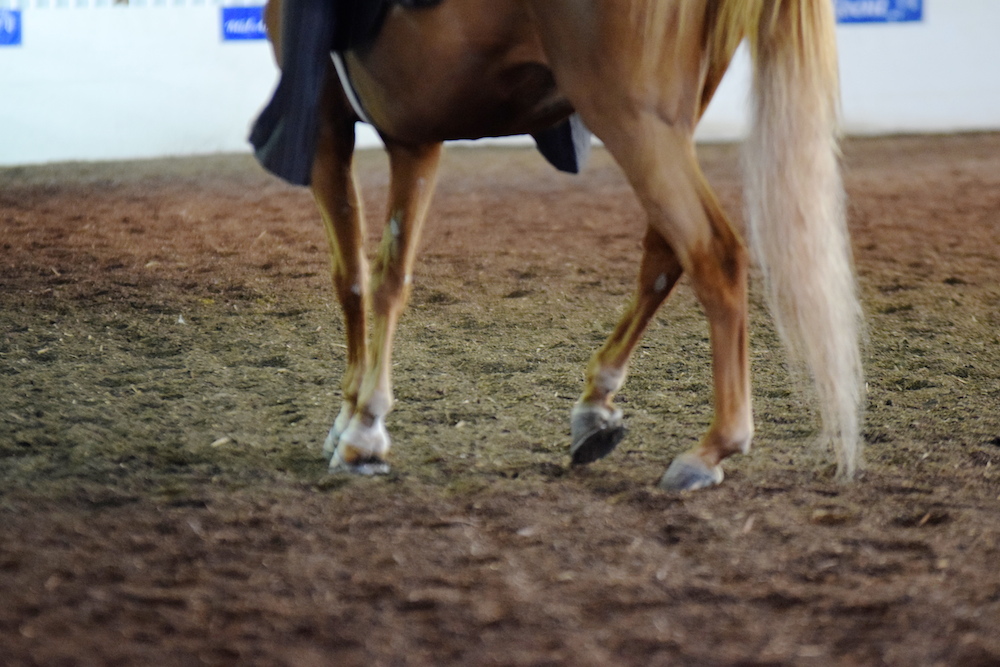
The question is understandable, as saddle seat equitation rules do not actually specify whether riders should perform a turn on the forehand, a turn on the haunches, or some hybrid of the two. In a sport that seems to spell out everything, from suit colors to where the bight of the reins should fall, this lack of clarity may seem frustrating at first glance. However, it may also be a chance for riders to demonstrate their horsemanship skills in a way that goes above and beyond anything written rules could’ve called for.
There was a time when turns in saddle seat equitation patterns were more often referred to as pivots. Today the term is used less frequently, and Carol Jones, trainer at American Acres in Little Rock, Arkansas, understands why.
Carol has had much success in the western discipline with Saddlebreds, but also in the Appaloosa industry, where pivots are extremely prevalent. While she doesn’t think western enthusiasts would get too worked up about the terminology used by saddle seat riders, the turns she sees most often in equitation classes would not be considered proper pivots by any other standard.
“It looks like the horse is moving all four feet at the same time and just gets going in a different direction,” she said.
Among western enthusiasts, this is known as a “Coke-bottle” turn. It is never a desired movement, as horses are either called to pivot on the front end or the hind end.

“In most of the stock breeds or western breeds there should be some consideration given to a pivot foot, meaning one foot remains on the ground and the rest of them are turning around it,” Carol said. “I guess an analogy would be in basketball when a player catches the ball. Unless they’re dribbling it, they have to leave one foot on the ground. They can spin around that foot, but they can’t pick that foot up.”
And a truly skilled rider should always be able to feel what the horse is doing underneath him or her.
“Part of horsemanship and equitation is knowing which part of your horse is moving,” she said. “I would think if the requirement is a turn on the haunch or turn on the forehand and that’s not performed, it certainly should be marked against the rider for not knowing that the wrong end is moving, or that both ends are moving.”
However, when it comes to saddle seat equitation, neither of those types of turns are actually a requirement, as a quick scan of the United States Equestrian Federation Rule Book’s section on saddle seat equitation shows. The rulebook lists sixteen tests that can be used in saddle seat equitation pattern work. Those tests can be called for individually or collectively, but they are the only tests that may be used, and therefore, judged. Performing a “pivot” is not one of them. It is for this reason that the United Professional Horsemen’s Association uses the terminology “turn” or “reposition” rather than “pivot” in its popular pattern book.
But while riders are technically free to perform whatever type of turn they would like, some qualities do make for a better turn than others. According to Gayle Lampe, judge and saddle seat professor emeritus at William Woods University, a horse that resists, roots down in the bridle, or wanders all over the place during the turn does not make an attractive picture, and sometimes denotes a rider’s lack of skill.
“I think the worst thing … is for the rider to use the hands too strongly and the legs not enough, resulting in the horse backing up,” she said.
But as long as the horse and rider avoid these major pitfalls, especially going backward or forward, she doesn’t think most judges are too concerned about what type of turn is used. One of these judges is Liz McBride-Jones, trainer and instructor at Forever Farm in Raeford, North Carolina.
Liz grew up riding with the legendary instructor Helen Crabtree during the early 1960s. According to Liz, Helen did not expect her riders to perform actual pivots. What she did expect, however, was that during the turn her riders were doing something to prepare their horses for the next gait.
“She was very clear about where you went and how you turned around,” Liz said. “You were not pivoting, standing and then going off. You were doing something to set yourself up for the next part.”
Perhaps because of this early education, as a judge Liz believes that any type of turn can be acceptable. Still, it is hard for her to suppress her excitement for a good turn on the forehand. The horse and rider combination she remembers performing them best was Nadine Van Zomeren and CH-EQ Heirronic. Since Heirronic was a big chestnut with four white legs, it was particularly satisfying to watch him pivot. And according to Nadine’s trainer and mother, Renee, he performed both turns on the forehand and turns on the haunches.

When teaching him to pivot, Renee followed the same system she always does.
“Forehand is what we teach first,” she said. “For us it’s always been the easiest, because you can kind of keep their face steady with your hands and then use your legs to move them.”
And since most riders are accustomed to displacing the horse’s hindquarters in order to pick up the proper canter lead, it’s not a big leap to continue moving them a few additional steps.
Once a horse and rider master the turn on the forehand, Renee moves on to teaching the turn on the haunches. It is important to her that they know both, because one can often work better than the other depending on the pattern and the rider’s position in the ring.
For example, when trotting or cantering up to the rail and turning to be parallel with the rail, it generally makes the most sense for the horse to plant its front hooves and pivot its haunches – a turn on the forehand. When turning off the rail toward center ring, it works best for a horse to plant its hind feet and pivot its front end – a turn on the haunches. For turns that take place completely off the rail any type could work, but Renee prefers her riders use a turn on the forehand.
“Because it’s harder to get the turn on the haunches correct, we only use it when you have to turn from the rail,” she said.
In all these instances, many riders do perform the Coke-bottle turn – often on purpose, sometimes by accident – with the rider serving as the pivot point. Renee believes that during patterns with diagonal lines, such as diamond patterns, Coke-bottle turns actually make the most sense, as they allow the horse and rider to perform the pattern as drawn, close to the rail and on the diagonal line.
The way the rules are currently written, none of these options are technically right or wrong. Some believe that the rules and requirements should be more clearly defined, but others believe that the lack of definition gives truly great riders the opportunity to shine.
“It’s about knowing what would look best in that pattern and knowing which of the pivots the horse does the best,” Renee said. “And that’s all about the close communication that you’ve built over time – that they know what that horse can do and where.”
After all, a rider who can know a pattern and his or her horse well enough to choose the most appropriate turn for the circumstances – and then execute it well – may be doing something even better than performing a required pivot. They are demonstrating horsemanship.



